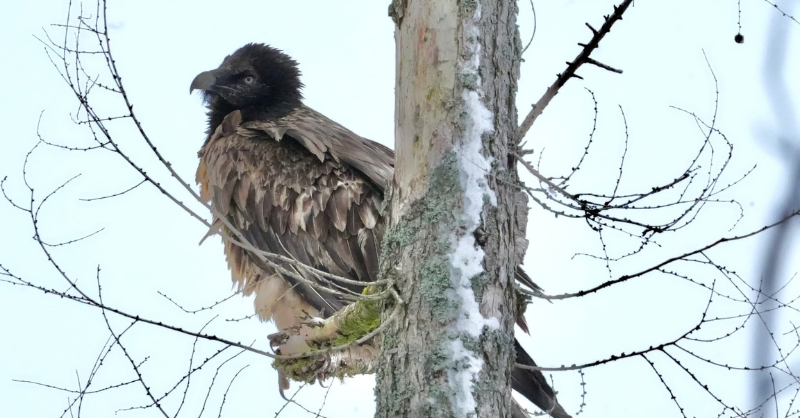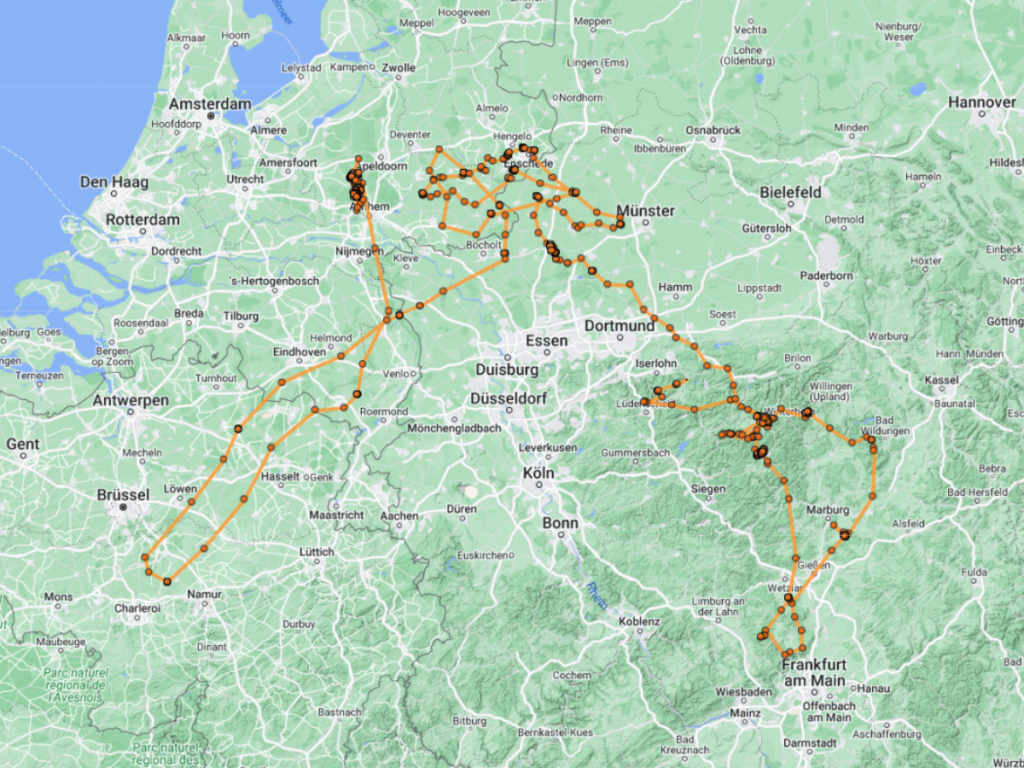
The Bearded Vulture Eglazine continues to surprise us as she winters in Germany! After returning for the second time to the Netherlands, where she spent the entire summer, Eglazine has now moved southward – but just slightly. Südwestfalen in Germany (the area between Dortmund and Frankfurt am Main) seems to be the place Eglazine chose to spend this winter, making it an extraordinary remark. It is the first time a Bearded Vulture spends the whole winter so far north, and therefore, we are following her movements closely to ensure she is safe and healthy.
From captive-breeding into the wild: Eglazine’s amazing excursions
Back in 2020, Eglazine hatched in captivity at Parco Natura Viva (Italy) within the Bearded Vulture Captive Breeding Network, coordinated by the Vulture Conservation Foundation (VCF) on behalf of EAZA’s EEP. When she reached 3 months old, Eglazine was transferred to a hacking facility in the Grands Causses (France) in the scope of the LIFE GypConnect project (2015-2022). The hacking method replicates the species’ natural way of fledging, allowing young Bearded Vultures to interact with other individuals in their new environment while getting ready for their first flight into the wild.
Ahead of her release, the local LPO team tagged and equipped Eglazine with a GPS transmitter for monitoring purposes. Her release in the Grands Causses strengthened the project’s ultimate and long-term objective to establish a Bearded Vulture breeding population in the Massif Central and the Pre-Alps.
During the first 9 months, Eglazine explored the Grands Causses and began her wandering adventure in April 2021. She flew over downtown Paris, entered Belgium and reached the Netherlands, where she toured around and went back and forth between Germany and the National Park Hoge Veluwe (NL). As autumn arrived, Eglazine headed south on 8 October, and it only took her two days to arrive in France, where she spent the winter back ‘home’ in the Grands Causses.
To our great surprise, on the following spring, Eglazine embarked on a new journey up north and returned to the Veluwe, roughly following the same route she made in autumn 2021. She spent the entire summer in the Netherlands, often changing her sleeping place, but never left the country. Even though wandering is normal for young individuals of this species, there are no previous records of a Bearded Vulture making such a journey to northwestern Europe twice.


A Bearded Vulture wintering in western Germany for the first time
As expected, Eglazine headed south on 18 October for her autumn return, but she did not get far this time. After reaching southern Brussels, the Bearded Vulture changed her route and flew northeast again, roaming between Enschede in the Netherlands and Münster in Germany for 2 weeks. Eventually, she made it to Südwestfalen and seems to ‘enjoy’ her stay there, making it the first time we ever recorded a Bearded Vulture wintering so far north.
Travelling vast distances is normal for young Bearded Vultures (a study in the Pyrenees even estimates that youngsters have a range of up to 10,000 km2). However, they tend to return to their mountainous habitats, typically after some weeks. The story of Eglazine is, therefore, quite special. After a long stay in northwest Europe on her first incursion (6 months), a return to the same area and now a full winter up north, Eglazine is showing an incredible capacity for adaptation.
Following Eglazine’s movements closely

The GPS transmitter gives us daily information about Eglazine’s location, and we regularly receive field reports from local observers. So far, she seems to be in good condition, but sometimes Bearded Vultures, both released and wild-hatched, face complications and need to be rescued and rehabilitated.
Although they can easily survive without food for a week (or even longer), our main concern regarding Eglazine’s wintering in Germany is food availability. Bearded Vultures specialised in feeding primarily on the bones of dead animals, making it about 85-90% of their diet. They are capable of swallowing and digesting bones the size of a sheep’s vertebrae and developed special skills for larger bones: the bird gains great heights of up to 100 metres and drops bones onto rocky surfaces to shatter them into eatable pieces, a practice that might take several years to master.
The landscape Eglazine chose for winter is very different from the typical mountain habitat where Bearded Vultures thrive but until now, she manages to find remains of roe deer and is feeding on them to survive. We will keep following Eglazine’s movements closely, and for her safety, we cannot reveal her exact location. If you come across Eglazine, it is essential to keep a safe distance and not approach her directly.
The LIFE GypConnect project

Led by the League pour la Protection des Oiseaux (LPO), the LIFE GypConnect project aimed to establish a breeding population of Bearded Vultures in the Massif Central and Department of the Drôme. The team released captive-bred Bearded Vultures into the wild at sites such as the Parc Naturel Régional des Grands Causses, Parc Naturel Régional des Baronnies Provençales and Parc Naturel Régional du Vercors to eventually create a core population that will connect the two populations of the species in the Alps and the Pyrenees. Furthermore, to facilitate movements between the new population and the Alpine and Pyrenean populations, the LIFE GypConnect team created a network of supplementary feeding stations and tackled threats such as poisoning, collision and electrocution with the electricity infrastructure. By the project’s end in 2022, a pair successfully bred in Vercors, fledging a Bearded Vulture in the area for the first time after 150 years.




